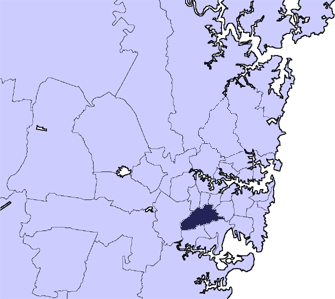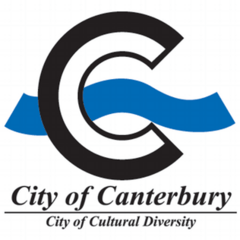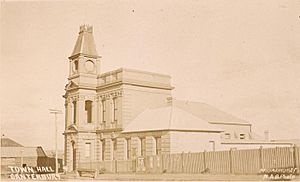City of Canterbury (New South Wales) facts for kids
Quick facts for kids City of CanterburyNew South Wales |
|||||||||||||||
|---|---|---|---|---|---|---|---|---|---|---|---|---|---|---|---|

Location in Metropolitan Sydney
|
|||||||||||||||
| Population | 146,314 (2012) | ||||||||||||||
| • Density | 4,303.45/km2 (11,145.9/sq mi) | ||||||||||||||
| Established | 17 March 1879 (Municipality) 16 November 1993 (City) |
||||||||||||||
| Abolished | 12 May 2016 | ||||||||||||||
| Area | 34 km2 (13.1 sq mi) | ||||||||||||||
| Mayor | Brian Robson (Labor Labor) | ||||||||||||||
| Council seat | Canterbury Administration Building, Campsie | ||||||||||||||
| Region | Inner West South West |
||||||||||||||
 |
|||||||||||||||
| Website | City of Canterbury | ||||||||||||||
|
|||||||||||||||
The City of Canterbury was a local government area in the south–west region of Sydney, New South Wales, Australia. The city was primarily residential and light industrial in character, and was home to over 130 nationalities. With a majority of its residents being born overseas, the council marketed itself as the "City of Cultural Diversity." First incorporated as the Municipality of Canterbury in 1879, the council became known as the City of Canterbury in 1993.
The last Mayor of the City of Canterbury Council was Cr. Brian Robson, a member of the Labor Party, until 12 May 2016 when the City was amalgamated with the City of Bankstown, forming the City of Canterbury-Bankstown.
Contents
Suburbs in the local government area
Suburbs in the former City of Canterbury were:
- Ashbury (with a minor portion within the Municipality of Ashfield)
- Belfield (with parts within the Municipality of Strathfield)
- Belmore
- Beverly Hills (with parts within the City of Hurstville)
- Campsie
- Canterbury
- Clemton Park
- Croydon Park (with parts within Burwood Council and the Municipality of Ashfield)
- Earlwood
- Hurlstone Park (with a minor portion with the Municipality of Ashfield)
- Kingsgrove (with parts within the City of Hurstville & City of Rockdale)
- Lakemba
- Narwee (with parts within the City of Hurstville)
- Punchbowl (with parts within the City of Bankstown)
- Riverwood (with parts within the City of Hurstville)
- Roselands
- Wiley Park
History
Indigenous Australians lived in this area for thousand of years. In 1770, the land along the Cooks River was explored by officers from HM Bark Endeavour. In 1793, the area's first land grant was made to the chaplain of the First Fleet, the Reverend Richard Johnson, and given the name Canterbury Vale.
Residential development began picking up in the area during the 1880s and the was extended to Canterbury in 1895, encouraging further suburban development which led to the area becoming heavily populated. A leading developer at this time was Frederick Gibbes, a Member of Parliament for the seat of Newtown.
After much petitioning of the State Government by local residents, the Municipality of Canterbury was proclaimed on 17 March 1879. The council first met in the home of the first mayor, Alderman John Sproule and premised were then leased in the St Paul's Church schoolroom at 47-49 Canterbury Road, Canterbury. The Canterbury Town Hall, located on Canterbury Road between Canton and Howard Streets, was opened in 1889 by the Premier of New South Wales, Sir Henry Parkes. However, over time, Campsie became a more important centre and in recognition of this the city administration moved there in 1963, with the Canterbury Municipal Administration Building, designed by architects Whitehead and Payne, being opened on Beamish Street by the mayor, James S. Scott, on 21 September 1963. The City of Canterbury was proclaimed on 16 November 1993 by the Governor of New South Wales, Rear Admiral Peter Sinclair.
Amalgamation
A 2015 review of local government boundaries by the NSW Government Independent Pricing and Regulatory Tribunal recommended that the City of Canterbury merge with the City of Bankstown to form a new council with an area of 110 square kilometres (42 sq mi) and support a population of approximately 351,000. Following an independent review, on 12 May 2016 the Minister for Local Government announced that the merger with the City of Bankstown would proceed with immediate effect, creating a new council with an area of 72 square kilometres (28 sq mi).
Demographics
At the 2011 Census, there were 137,454 people in the Canterbury local government area, with an equal proportion of male and female residents. Aboriginal and Torres Strait Islander people made up 0.6% of the population. The median age of people in the City of Canterbury was 35 years. Children aged 0 – 14 years made up 20.0% of the population and people aged 65 years and over made up 13.5% of the population. of people in the area aged 15 years and over, 52.9% were married and 10.8% were either divorced or separated.
Population growth in the City of Canterbury between the 2001 Census and the 2006 Census was 0.02%; and in the subsequent five years to the 2011 Census, population growth was 5.76%. When compared with total population growth of Australia for the same periods, being 5.78% and 8.32% respectively, population growth in Canterbury local government area was approximately half the national average. The median weekly income for residents within the City of Canterbury is significantly lower than the national average.
| Selected historical census data for Canterbury local government area | |||||
|---|---|---|---|---|---|
| Census year | 2001 | 2006 | 2011 | ||
| Population | Estimated residents on Census night | 129,935 | 129,963 | 137,454 | |
| LGA rank in terms of size within New South Wales | |||||
| % of New South Wales population | 1.99% | ||||
| % of Australian population | 0.69% | ||||
| Cultural and language diversity | |||||
| Ancestry, top responses |
Chinese | 11.6% | |||
| Australian | 9.7% | ||||
| Lebanese | 9.5% | ||||
| Greek | 9.5% | ||||
| English | 8.9% | ||||
| Language, top responses (other than English) |
Arabic | 12.2% | |||
| Greek | 11.1% | ||||
| Mandarin | 1.7% | ||||
| Cantonese | 2.7% | ||||
| Vietnamese | n/c | ||||
| Religious affiliation | |||||
| Religious affiliation, top responses |
Catholic | 43.4% | |||
| Islam | 5.1% | ||||
| Eastern Orthodox | 15.8% | ||||
| No religion | 11.1% | ||||
| Buddhism | n/c | n/c | |||
| Median weekly incomes | |||||
| Personal income | Median weekly personal income | A$366 | A$430 | ||
| % of Australian median income | 78.5% | 74.5% | |||
| Family income | Median weekly family income | A$839 | A$1,149 | ||
| % of Australian median income | 81.7% | 77.6% | |||
| Household income | Median weekly household income | A$1,007 | A$1,029 | ||
| % of Australian median income | 86.0% | 83.4% | |||
Coat of arms and logo
 |
|
Logo
In 1990, the council's Engineering Department produced the logo in everyday usage until 2016, it consisted of two C's in black and white, intersected by a wave in light blue, which represents the Cooks River and is taken from the council arms issued in 1979.
Sister cities
 Eunpyong-gu, Seoul, South Korea. A special friendship garden in Loft Gardens at Campsie commemorating the relationship begun in 1988, in the design of the Taegukgi, was unveiled in November 2000 by the mayors of Canterbury and Eunpyong-gu.
Eunpyong-gu, Seoul, South Korea. A special friendship garden in Loft Gardens at Campsie commemorating the relationship begun in 1988, in the design of the Taegukgi, was unveiled in November 2000 by the mayors of Canterbury and Eunpyong-gu. Patras, Greece.
Patras, Greece.
Images for kids
-
The Administration Building on Beamish Street, Campsie, was the seat of Canterbury Council from 1963–2016. It was designed by architects Whitehead & Payne and built by Rex Building Company P/L, to complete the 'civic centre' with the adjacent library and baby health centre. It is now secondary offices for the City of Canterbury Bankstown.





